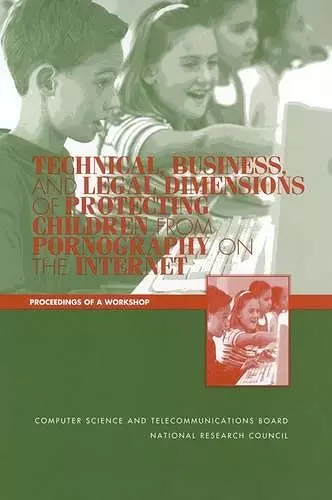Technical, Business, and Legal Dimensions of Protecting Children from Pornography on the Internet
Proceedings of a Workshop
National Research Council author Division on Engineering and Physical Sciences author Institute of Medicine author Division of Behavioral and Social Sciences and Education author Computer Science and Telecommunications Board author Board on Children, Youth, and Families author Committee to Study Tools and Strategies for Protecting Kids from Pornography and Their Applicability to Other Inappropriate Internet Content author
Format:Paperback
Publisher:National Academies Press
Published:29th Apr '02
Currently unavailable, our supplier has not provided us a restock date

In response to a mandate from Congress in conjunction with the Protection of Children from Sexual Predators Act of 1998, the Computer Science and Telecommunications Board (CSTB) and the Board on Children, Youth, and Families of the National Research Council (NRC) and the Institute of Medicine established the Committee to Study Tools and Strategies for Protecting Kids from Pornography and Their Applicability to Other Inappropriate Internet Content.
To collect input and to disseminate useful information to the nation on this question, the committee held two public workshops. On December 13, 2000, in Washington, D.C., the committee convened a workshop to focus on nontechnical strategies that could be effective in a broad range of settings (e.g., home, school, libraries) in which young people might be online. This workshop brought together researchers, educators, policy makers, and other key stakeholders to consider and discuss these approaches and to identify some of the benefits and limitations of various nontechnical strategies. The December workshop is summarized in Nontechnical Strategies to Reduce Children's Exposure to Inappropriate Material on the Internet: Summary of a Workshop. The second workshop was held on March 7, 2001, in Redwood City, California. This second workshop focused on some of the technical, business, and legal factors that affect how one might choose to protect kids from pornography on the Internet. The present report provides, in the form of edited transcripts, the presentations at that workshop.
Table of Contents- Front Matter
- 1 Basic Concepts in Information Retrieval
- 2 Text Categorization and Analysis
- 3 Categorization of Images
- 4 The Technology of Search Engines
- 5 Cyber Patrol: A Major Filtering Project
- 6 Advanced Techniques for Automatic Web Filtering
- 7 A Critique of Filtering
- 8 Authentication Technologies
- 9 Infrastructure for Age Verification
- 10 Automated Policy Preference Negotiation
- 11 Digital Rights Management Technology
- 12 A Trusted Third Party in Digital Rights
- 13 Problems with a Dot-XXX Domain
- 14 Business Dimensions: The Education Market
- 15 Business Models: Kid-Friendly Internet Businesses
- 16 Business Models Based on Advertising
- 17 Constitutional Law and the Law of Cyberspace
- Appendix: Biographies of Presenters <
ISBN: 9780309083263
Dimensions: unknown
Weight: unknown
144 pages